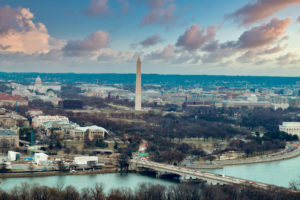
The last five years saw a fundamental shift in how the government interacts with the public.
RegBlog’s founding in 2011 was an ambitious, creative, and prescient undertaking. It was also very much a sign of the times, reflecting the increasing comfort with—and saturation by—social media throughout society.
Federal agencies, too, were leaping on this bandwagon. In 2010, the Federal Web Managers Council, an interagency group of web managers working to improve the United States governments’ online presence, created a timeline to trace the federal government’s embrace of social media. The first item, somewhat pathetic in retrospect, is from April 1, 2002, when the White House Easter Egg Roll was live-streamed. The next item does not appear for another two years, but the timeline is increasingly crammed with developments in the ensuing years.
Then, in September 2011, the timeline just stops.
The timeline stops not because social media activities came to an end, but because by 2011 it was no longer even moderately notable when an agency used social media.
Clay Shirky, a writer on Internet technologies, once observed that “communications tools don’t get socially interesting until they get technologically boring. . . . It’s when a technology becomes normal, then ubiquitous, and finally so pervasive as to be invisible, that the really profound changes happen.” If we are looking for when federal agencies’ use of social media went from normal to ubiquitous, the abandonment of the timeline suggests that 2011 is not a bad estimate.
What, then, can we make of these five years of social media ubiquity? Now that these tools are “technologically boring,” have they become “socially interesting”?
There are currently an estimated 10,000 federal government social media accounts across dozens of different platforms. (For an impressive array from just a single agency, see the list on the U.S. Environmental Protection Agency’s (EPA) social media page.) For all the theorizing about social media as a dialogic network, fostering feedback and engagement by customers and citizens, agencies overwhelmingly rely on these platforms to push rather than to pull, to get their “story” out there. In other words, these platforms are the tools of modern government public relations.
Governmental publicity has always stirred controversy. As long ago as 1913, Congress prohibited agencies from hiring “publicity experts.” Slightly amended, this provision remains in the U.S. Code to this day. And since 1951, virtually every appropriations measure has provided that “no part of any appropriation contained in this Act shall be used for publicity or propaganda purposes not authorized by the Congress.” This restriction occasionally trips up agencies that seek to engineer positive media coverage by writing and disseminating pre-packaged news stories.
The most recent dust-up involving the propaganda prohibition concerns EPA. In 2014, EPA undertook an extensive social media campaign to rally public support for a proposed rule to clarify the regulatory definition of “waters of the United States.” Among other techniques, the agency used the aggregating tool Thunderclap to coordinate hundreds of simultaneous tweets of a text composed by EPA that read: “Clean water is important to me. I support EPA’s efforts to protect it for my health, my family, and my community.” The U.S. Government Accountability Office (GAO) concluded that this violated the prohibition on propaganda because EPA’s role in originating the message was hidden—the millions of followers who received the Thunderclap message did not know the tweet originated with EPA.
The only legal penalty for violating the appropriations rider is for the offending agency to return funds to the treasury. The greater consequence, of course, is the public and political relations harm from being labeled a distributor of “covert propaganda”—that being the only sort of propaganda the GAO understands the prohibition to reach.
As a result, the prohibition on agency publicity or propaganda is used primarily to arm agency critics with ammunition for anti-agency publicity and propaganda.
And that is just how it was used in this instance. GAO’s conclusion played directly into what EPA’s harshest critics believe about the agency. For example, U.S. Senator James Inhofe (R-Okla.), the Chairman of the Senate Committee on Environment & Public Works, stated that the report confirmed what he had “long suspected, that EPA will go to extreme lengths and even violate the law to promote its activist environmental agenda.” The U.S. Chamber of Commerce lamented that “‘covert propaganda’ is something you’d expect from a foreign spy agency not from EPA.” In fact, covert propaganda is exactly what the Chamber, and other EPA opponents, expect from the agency. EPA’s critics have long attacked the agency for spewing misinformation, saying that “EPA” stands for “Environmental Propaganda Agency.”
The alleged illegality—EPA insists that no violation occurred—is a sideshow. However, the overall setting, like the trend of which it is a part, represents a fundamental shift in how government agencies interact with the public.
First, agencies indisputably are engaged in publicity and propaganda. Anyone who follows a federal agency on Twitter, Instagram, YouTube, or Facebook, or who has read an agency blog or visited an agency website, would be rather surprised to learn that agencies are not permitted to engage in “publicity” or “propaganda.” What else are social media tools for? No need to hire a publicist; in the social media age, that is what all of us are.
Second, this phenomenon does not, as some critics claim, amount to brainwashing the American public. Counter-speech on the Internet is robust. That is what it means for all of us to be publicists. Indeed, the government is at a disadvantage in social media battles. The material that goes viral is creative and, even more important, subversive. Government has a hard time being creative, and it simply cannot be subversive. For example, the Transportation Security Administration (TSA) currently has 90 videos on YouTube. As government videos go, these have an enormous number of views. But their popularity is dwarfed by that of anti-TSA videos. Inescapably, more people will watch “Another TSA Video To Make Your Blood Boil” (5 million) than will watch “Why Shoes on the Belt?” (27,000).
Finally, the most striking aspect of the EPA’s waters of the United States social media campaign was that it occurred in the context of a pending rulemaking. Since notice-and-comment rulemaking moved online, observers have worried that this historically technocratic process would become a plebiscite. While commenters and government websites alike admonish against such a shift, a built-in pressure in that direction results simply from the use of the technologies of mass participation. Problematically, EPA encouraged the mistaken view, too evident already on some NGO websites, that commenting is not about providing information or argument, but simply about showing “support”—a petition or referendum in which numbers trump all other considerations.
Agencies will continue to refine their social media presence to convince the public of the value of the agencies’ work. These efforts may be indispensable measures to inform the public and so ensure a functioning democracy. Or they may be pathological artifacts of the permanent campaign, distracting at best and deceptive at worst. Whichever they are, the last five years have shown that the old issues—agency expertise, discretion, and democratic deficit—are now inextricably bound up with use of the new technologies.
This essay is part of RegBlog’s sixteen-part series, RegBlog@5.




